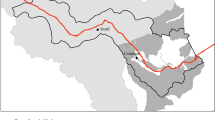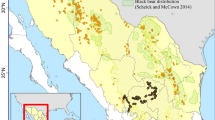Abstract
Population recovery is difficult for species that require large contiguous areas of habitat, particularly within areas of heterogeneous land ownerships. Ecologically, potential for recovery success requires assessment of quantity, quality, and distribution of available habitat. Our objective was to evaluate habitat for a possible Louisiana black bear recovery in southeastern Texas. First, we categorized land cover and identified remote areas of highly suitable habitat. Next, we used the individual based simulation model J-walk to estimate ability of female black bears to move among remote habitat patches. Then, we applied graph theory to J-walk output to evaluate overall connectivity of remote habitat. An estimated 225,626 ha of remote habitat were identified in 901 patches, most of which was located within the eastern half of the study area. Network analysis showed specific areas where targeted conservation efforts may help black bear population expansion throughout the study region. Ultimately, enough habitat area exists to sustain a black bear population and it is best connected among public and private lands largely within the eastern half of the study area. Habitat evaluation will need to be revisited if black bears establish themselves locally and actual habitat use data become available. Regardless, our analysis demonstrates an important first step that may be incorporated into a larger adaptive management framework, updated, and replicated as more-detailed habitat suitability and land use data are available.





Similar content being viewed by others
References
Anderson DR (1997) Corridor use, feeding ecology, and habitat relationships of black bears in a fragmented landscape in Louisiana. Thesis, University of Tennessee
Batagelj V, Mrvar A (2010) Pajek 1.26. http://pajek.imfm.si/doku.php?id=pajek
Beausoleil BA (1999) Population and spatial ecology of the Louisiana black bear in a fragmented bottomland hardwood forest. Thesis, University of Tennessee
Black Bear Conservation Committee (BBCC) (1997) Black bear restoration plan. Black Bear Conservation Committee, Baton Rouge
Bowker B, Jacobson T (1995) Louisiana black bear (Ursus americanus luteolus) recovery plan. US Fish and Wildlife Service, Atlanta
Bunn AG, Urban DL, Keitt TH (2000) Landscape connectivity: a conservation application of graph theory. J Environ Manage 59:265–278
Calabrese JM, Fagan WF (2004) A comparison-shopper’s guide to connectivity metrics. Front Ecol Environ 2:529–536
Clark JD, Dunn JE, Smith KG (1993) A multivariate model of female black bear habitat use for a geographic information system. J Wildl Manage 57:519–526
Clark JD, Huber D, Servheen C (2002) Bear reintroductions: lessons and challenges. Ursus 13:335–345
Dijkstra EW (1959) A note on two problems in connection with graphs. Numer Math 1:269–271
Eastridge R (2000) Experimental repatriation of black bears to the Big South Fork Area of Kentucky and Tennessee. Thesis, University of Tennessee
Eastridge R, Clark JD (2001) Evaluation of 2 soft-release techniques to reintroduce black bears. Wildl Soc B 29:1163–1174
Ferrari, JR (2005) Graph theoretic connectivity analysis of the Mid-Atlantic region of the United States. Thesis, University of Maryland
Ferrari JR, Lookingbill TR (2009) Initial conditions and their effect on invasion velocity. Biol Invasions 11:1247–1258
Ferrari JR, Lookingbill TR, Neel MC (2007) Two measures of landscape-graph connectivity: assessment across gradients in area and configuration. Landscape Ecol 22:1315–1323
Freeman LC (1977) A set of measures of centrality based on betweenness. Sociometry 40:35–41
Gardner RH, Gustafson EJ (2004) Simulating dispersal of reintroduced species within heterogeneous landscapes. Ecol Model 171:339–358
Garner NP (1996) Suitability of habitats in east Texas for black bears. Texas Parks and Wildlife Department, Tyler
Garshelis DL, Pelton MR (1981) Movement of black bears in the Great Smoky Mountains National Park. J Wildl Manage 45:912–925
Gross JL, Yellen J (2006) Graph theory and its applications, 2nd edn. Chapman & Hall/CRC, Boca Raton
Gurd DB, Nudds TD, Rivard DH (2001) Conservation of mammals in eastern North American wildlife reserves: how small is too small? Conserv Biol 15:1355–1363
Hamilton D (1999) Controversy in times of plenty. Mo Conserv 60:17–23
Harcombe PA, Callaway G (1997) Management assessment of the water corridor units of Big Thicket National Preserve. National Park Service, Beaumont
Harcombe PA, Marks PL (1977) Understory structure of a mesic forest in southeast Texas. Ecology 58:1144–1151
Hellgren EC, Vaughan MR (1989) Demographic analysis of a black bear population in the Great Dismal Swamp. J Wildl Manage 53:969–977
Hellgren EC, Vaughan MR (1990) Range dynamics of black bears in the Great Dismal Swamp, Virginia-North Carolina. In: Proceedings of Annual Conference of the SEAFWA, vol 44, pp 268–278
Hellgren EC, Vaughan MR, Stauffer DF (1991) Macrohabitat use by black bears in a southeastern wetland. J Wildl Manage 55:442–448
Keitt TH, Urban DL, Milne BT (1997) Detecting critical scales in fragmented landscapes. Cons Ecol 1:4. http://www.consecol.org/vol1/iss1/art4/
Larivière S (2001) Ursus americanus. Mamm Species 647:1–11
Larkin JL, Maehr DS, Hoctor TS, Orlando MA, Whitney K (2004) Landscape linkages and conservation planning for the black bear in west-central Florida. Anim Conserv 7:23–34
Lee DJ, Vaughan MR (2004) Black bear family breakup in western Virginia. Northeast Nat 11:111–122
Lindsey PA, du Toit JT, Mills MGL (2005) Attitudes of ranchers toward African wild dogs Lycaon pictus: conservation implications on private land. Biol Conserv 25:113–121
Linnell JDC, Swenson JE, Andersen R, Barnes B (2000) How vulnerable are denning bears to disturbance? Wildl Soc B 28:400–413
Liu J, Linderman M, Ouyang ZY, An L, Yang J, Zhang H (2001) Ecological degradation in protected areas: the case of Wolong Nature Reserve for giant pandas. Science 292:98–101
Lookingbill TR, Gardner RH, Ferrari JR, Keller CE (2010) Combing a dispersal model with network theory to assess habitat connectivity. Ecol Appl 20:427–441
Maehr DS, Noss RF, Larkin JL (2001) Large mammal restoration. Island Press, Washington
Maehr DS, Smith JS, Cunningham MW, Barnwell ME, Larkin J, Orlando MA (2003) Spatial characteristics of an isolated Florida black bear population. Southeast Nat 2:433–446
Marchinton FB (1995) Movement ecology of black bears in a fragmented bottomland hardwood habitat in Louisiana. Thesis, University of Tennessee
Marks PL, Harcombe PA (1981) Forest vegetation of the Big Thicket, southeast Texas. Ecol Monogr 51:287–305
Miller JR, Turner MG, Smithwick EAH, Dent CL, Stanley EH (2004) Spatial extrapolation: the science of predicting ecological patterns and processes. Bioscience 54:310–320
Minor ES, Urban DL (2007) Graph theory as a proxy for spatially explicit population models in conservation planning. Ecol Appl 17:1771–1782
Minor ES, Urban DL (2008) A graph-theory framework for evaluating landscape connectivity and conservation planning. Conserv Biol 22:297–307
Morzillo AT, Mertig AG, Garner N, Liu J (2007a) Resident attitudes toward black bears and population recovery in East Texas. Hum Dim Wildl 12:417–428
Morzillo AT, Mertig AG, Garner N, Liu J (2007b) Spatial distribution of attitudes toward proposed management strategies for a wildlife recovery. Hum Dim Wildl 12:15–29
Morzillo AT, Mertig AG, Garner N, Liu J (2009) Evaluating support for black bear restoration in East Texas. Hum Dim Wildl 14:407–418
Morzillo AT, Mertig AG, Hollister JW, Garner N, Liu J (2010) Socioeconomic factors affecting local support for black bear recovery strategies. Environ Manage 45:1299–1311
Nyland PD (1995) Black bear habitat relationships in coastal Louisiana. Thesis, Louisiana State University
Onorato DP, Hellgren EC (2001) Black bear at the border: natural recolonization of theTrans-Pecos. In: Maehr DS, Noss RF, Larkin JL (eds) Large mammal restoration. Island Press, Washington, pp 245–259
Osborne PE, Alonso JC, Bryant RG (2001) Modelling landscape-scale habitat use using GIS and remote sensing: a case study with great bustards. J Appl Ecol 38:458–471
Ovaskainen O (2008) Analytical and numerical tools for diffusion-based movement models. Theor Pop Biol 73:198–211
Peacock H (1984) The Big Thicket of Texas: America’s ecological wonder. Little Brown and Company, Boston
Pelton MR (1986) Habitat needs of black bears in the east. In: Kulhavy DL, Conner RN (eds) Wilderness and natural areas in the eastern United States: a management challenge. Stephen F. Austin State University, Nacogdoches, pp 49–53
Pelton MR (2003) Black bear. In: Feldhamer GA, Thompson BC, Chapman JA (eds) Wild mammals of North America, 2nd edn. John Hopkins University Press, Baltimore, pp 547–555
Pitt JPW, Worner SP, Suarez AV (2009) Predicting Argentine ant spread over the heterogeneous landscape using a spatially explicit stochastic model. Ecol Appl 19:1176–1186
Reading RP, Clark TW (1996) Carnivore reintroductions: an interdisciplinary examination. In: Gittleman JL (ed) Carnivore behavior, ecology, and evolution, vol 2. Cornell University Press, Ithaca, pp 296–336
Reynolds DG, Beecham JJ (1980) Home range activities and reproduction of black bears in west-central Idaho. Bear Biol Assoc Conf Series 3:181–191
Rogers LL (1987) Effects of food supply and kinship on social behavior, movements, and population growth of black bears in northern Minnesota. Wildl Monogr 91:1–72
Rudis VA (1986) Emerging patterns in the distribution of roadless forested areas in the Midsouth. In: Kulhavy DL, Conner RN (eds) Wilderness and natural areas in the eastern United States: a management challenge. Stephen F. Austin State University, Nacogdoches, pp 265–270
Rudis VA, Tansey B (1995) Regional assessment of remote forests and black bear habitat from forest resource surveys. J Wildl Manage 59:170–180
Saura S, Pascual-Hortal L (2007) A new habitat availability index to integrate connectivity in landscape conservation planning: comparison with existing indices and application to a case study. Landsc Urban Plan 83:91–103
Schamberger MA, Farmer H, Terrell JW (1982) Habitat suitability index models: introduction. US Fish and Wildlife Service, Washington
Schwartz CC, Miller SD, Haroldson MA (2003) Grizzly bear (Ursus arctos). In: Feldhamer GA, Thompson BC, Chapman JA (eds) Wild mammals of North America, 2nd edn. John Hopkins University Press, Baltimore, pp 556–586
Texas Parks Wildlife Department (TPWD) (2005) East Texas black bear conservation and management plan. Texas Parks and Wildlife Department, Austin
Turner MG, Gardner RH, O’Neill RV (2001) Landscape ecology. Springer-Verlag, Inc, New York
Urban DL (2003) LANDGRAPHS: a package for graph theoretic analyses of landscapes. Landscape Ecology Laboratory, Duke University, Durham NC
Urban D, Keitt T (2001) Landscape connectivity: a graph-theoretic perspective. Ecology 82:1205–1218
US Fish Wildlife Service (USFWS) (1981) Standards for the development of habitat suitability index models for use in the habitat evaluation procedures. Division of Ecological Services, Washington
van Manen FT (1991) A feasibility study for the potential reintroduction of black bears into the Big South Fork Area of Kentucky and Tennessee. Tennessee Wildlife Resources Agency, Morristown
Vogt P, Ferrari JR, Lookingbill TR, Gardner RH, Ritters KH, Ostapowicz K (2008) Mapping functional connectivity. Ecol Indic 9:64–71
Wagner RO (1990) Movement patterns of black bears in south central Louisiana. Thesis, Louisiana State University
Wear BJ, Eastridge R, Clark JD (2005) Factors affecting settling, survival, and viability of black bears reintroduced to Felsenthal National Wildlife Refuge, Arkansas. Wildl Soc B 33:1363–1374
Weaver KM, Tabberer DK, Moore LU Jr, Chandler GA, Posey JC, Pelton MR (1990) Bottomland hardwood forest management for black bears in Louisiana. Proceedings of Annual Conference of SEAFWA, vol 44, pp 342–350
White TH Jr, Bowman JL, Leopold BD, Jacobson HA, Smith WP, Vilella FJ (2000) Influence of Mississippi alluvial valley rivers on black bear movements and dispersal: implications for Louisiana black bear recovery. Biol Conserv 95:323–331
Wooding JB, Hardisky TS (1994) Home range, habitat use, and mortality of black bears in north-central Florida. Proceedings of 9th International Conference on Bear Research and Management, vol 9, pp 349–356
Woodroffe R (2001) Predators and people: using human densities to interpret declines of large carnivores. Anim Conserv 3:165–173
Yook SH, Jeong H, Barabasi AL, Tu Y (2001) Weighted evolving networks. Phys Rev Lett 86:5835–5838
Acknowledgments
Funding for this research was provided by Michigan State University, the NASA Earth Systems Science Fellowship Program, Canon-National Park Service Fellowship Program, National Fish and Wildlife Foundation, Western National Parks Assoc., Texas Parks and Wildlife Dept, and Safari Club International-Deep Pineywoods Chapter. The US Fish and Wildlife Service, US National Park Service, and Big Thicket Association provided in-kind support. We thank J. Egeler, S. Keroson, C. Jenkins, B. Maurer, and particularly R.H. Gardner, as well as N. Schumaker, E. Hellgren, and 4 anonymous reviewers.
Author information
Authors and Affiliations
Corresponding author
Rights and permissions
About this article
Cite this article
Morzillo, A.T., Ferrari, J.R. & Liu, J. An integration of habitat evaluation, individual based modeling, and graph theory for a potential black bear population recovery in southeastern Texas, USA. Landscape Ecol 26, 69–81 (2011). https://doi.org/10.1007/s10980-010-9536-4
Received:
Accepted:
Published:
Issue Date:
DOI: https://doi.org/10.1007/s10980-010-9536-4




